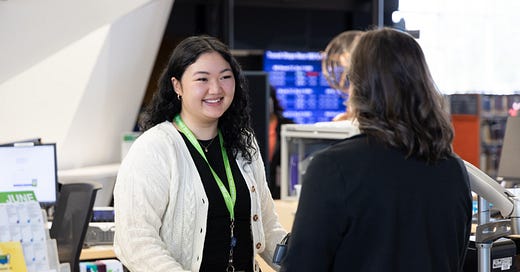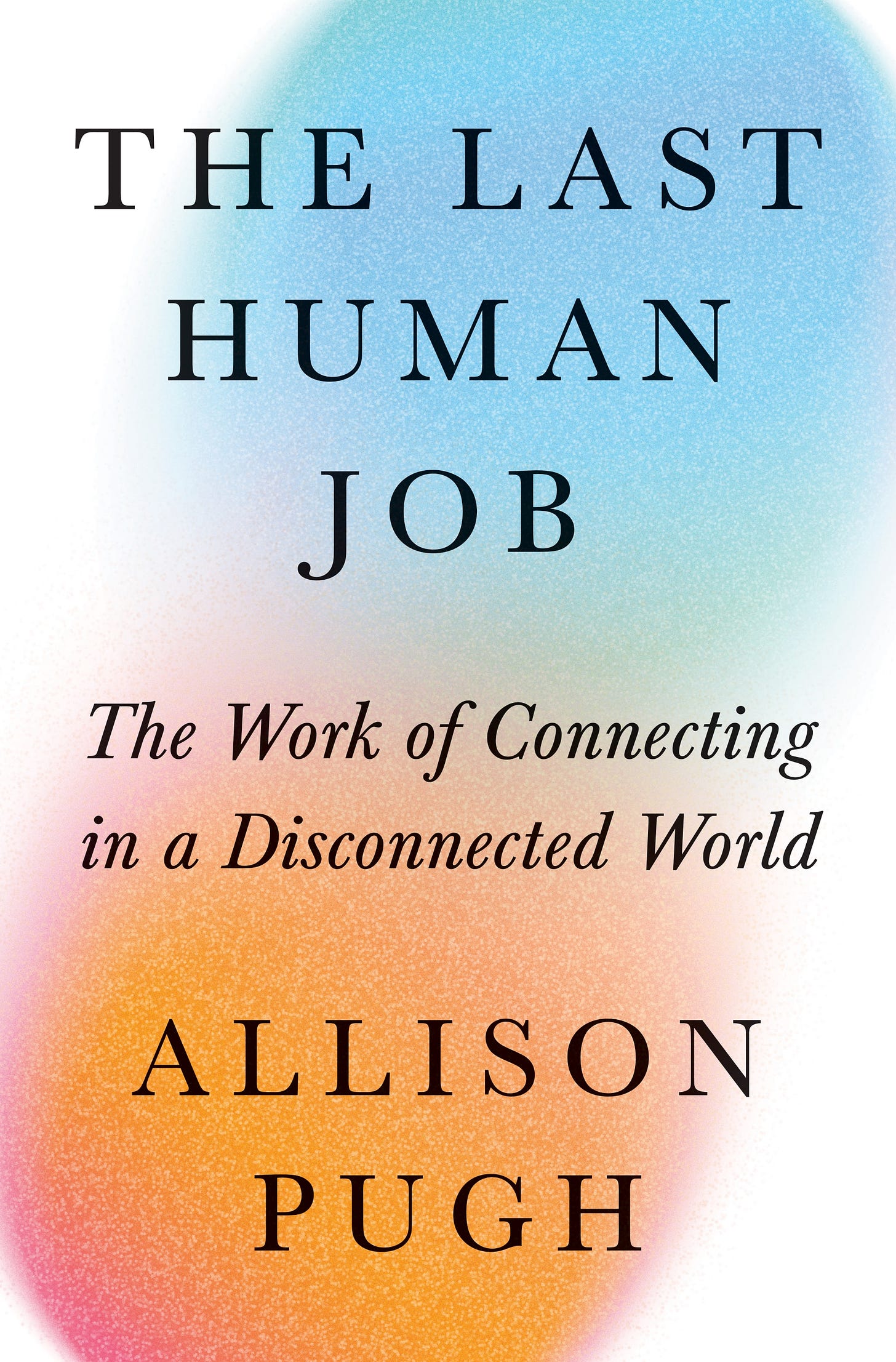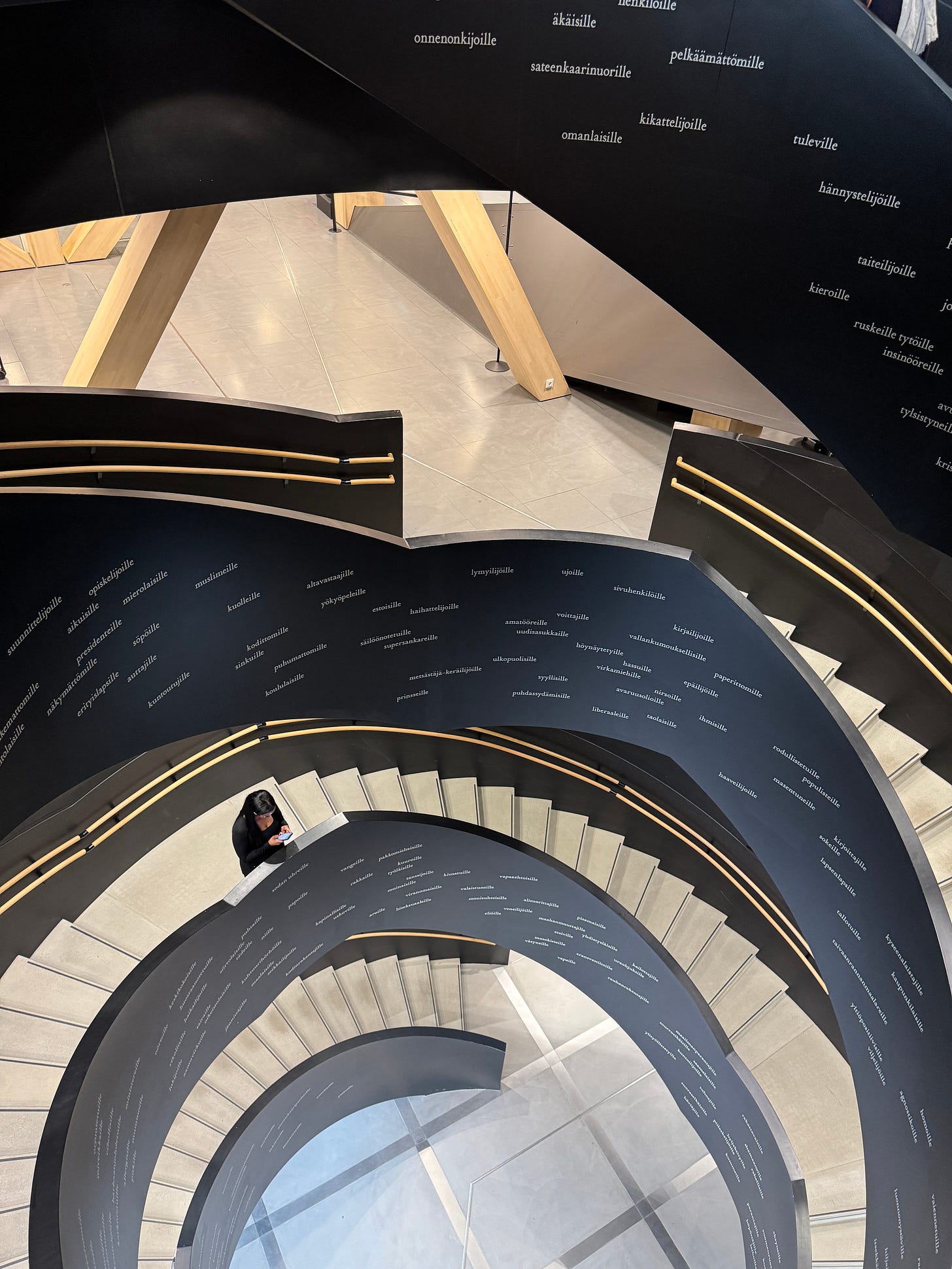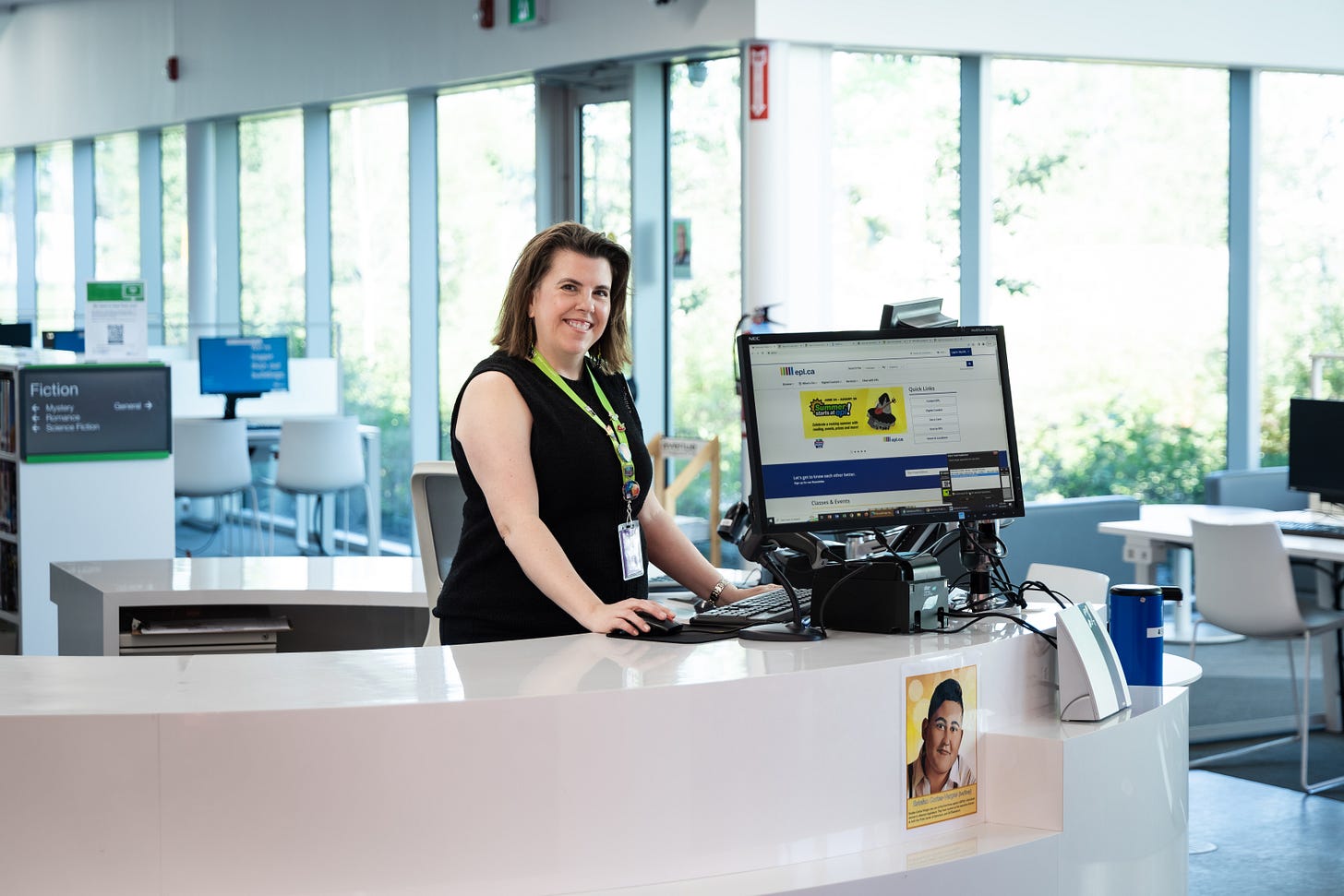Library Work Is Connective Labor
Allison Pugh’s book The Last Human Job provides a new way to talk about the magic of seeing and feeling seen in care professions.
I've spent most of my career in the civic sector, leading service delivery and advocating to decision makers and stakeholders the value of this work. To be frank, often explaining why these professionals deserve respect and a decent pay. Explaining the work in libraries or youth clubs is not easy. Statistics, like the number of interactions, really does not capture the magic or the real impact.
This was one of the reasons why the convivencia work we recently completed with Edmonton Public Library felt so rewarding. Over six months and inspired by nearly 1,000 contributions from staff, we crafted new language to talk about the day-to-day work in an inspiring yet honest manner. The best feedback was when staff members said that they felt seen.
I know that library work is meaningful and complex. For these reasons, Allison Pugh’s book The Last Human Job - The Work of Connecting in a Disconnected World felt so important. Professor Pugh argues—based on hundreds of hours of observing the work of hairdressers, medical doctors, teachers, nurses and social workers—that the full impact of this work cannot be understood based on a transactional service delivery mindset.
Next to delivering a service, these professions are what Professor Pugh calls connective labor. That is the wonder of two people—one of them a professional—engaging with each other, feeling seen, and seeing the other.
I was thrilled when Allison Pugh agreed to have a conversation on connective labor and how it relates to work in public spaces. The conversation below is redacted for clarity.
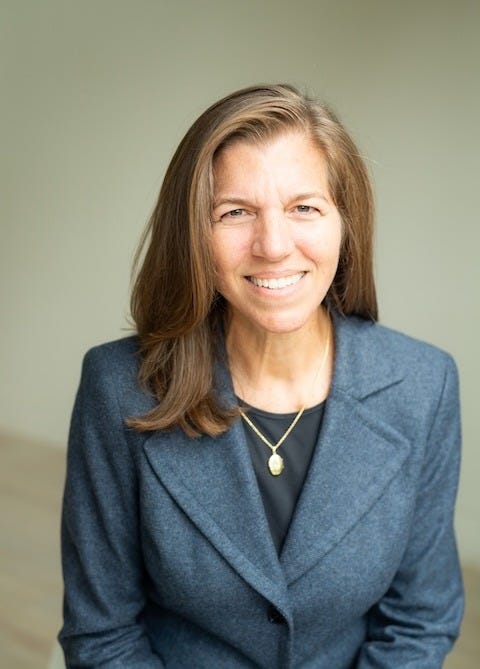
Tommi: Allison, your book is based on hours and hours spent with nurses, doctors, social workers and many other kinds of service and care professionals. You say that connective labor is quite difficult to talk about. What is connected labor and why is it difficult to talk about?
Allison: Connective labor is the work that people do to see the other and when the other person feels seen. Most often it's done to get outcomes that we value. So teachers see students, students feel seen, and they actually engage more in the thing they're supposed to be learning. They learn more. That's the ideal case.
Connective labor has a couple of components. It's that I'm seeing you, but you also have to feel seen. If I'm seeing you and you're not feeling seen, it's not working. It emphasizes the two-way, mutual constitution. It's a thing we produce together.
That mutuality is one of the reasons why it's hard for us to talk about. Analysts and scholars and practitioners have been talking for a long time about the work of caring for another person. They look at it from an individual perspective. We might think about emotional intelligence or emotional labor. In all of these things, the individual person is doing the work. My goal with connective labor is to get people to focus on the relationship, on what happens between people.
The other reason why it's hard to talk about is because it evades or eludes measurement. We are in an intense measurement regime where it almost feels like things don't exist if they aren't measured. This book is trying to push back on that.
Tommi: You describe the three threads of connection in connective labor—dignity, purpose, and understanding. Could you expand on these three threads and how they shape the impact of connective labor?
Allison: This is so important for the people you work with, librarians. They help us figure out what books we need to read or direct us to resources that we need for a particular project.
But the actual work of librarians is so much greater.
They stitch us together.
They create space for civic life and for community.
The three contributions or outcomes [dignity, purpose, understanding] that come out of connective labor are things that happen in addition to whatever outcome we're paying for or valuing. So, in addition to a teacher teaching math, in addition to a therapist counseling someone about depression, connective labor creates this deep meaning. The dignity, purpose and understanding go back to the mutuality point. They go in both directions.
Take dignity. Seeing another person is a way to communicate to that person that you are a human being worthy of being seen by another human being. I found again and again talking to people who do this work for a living that being seen helps them get in touch with their own humanity. It has this reciprocal effect that transcends whatever ostensible task that people get paid to do.
Tommi: In my work—both when I led the youth department for the City of Helsinki and now in my work with library professionals—I’ve seen many struggle. On one hand, they need to maintain professional boundaries, follow organizational policies, and stick to their defined responsibilities. On the other, they are fellow human beings, often interacting with people experiencing trauma, pain, or loneliness.
When a city is facing a major mental health crisis, a housing crisis, or an opioid crisis, those realities shape the library. Many library staff members tell me that they were not trained for this. They feel that the unpredictability and complexity of their daily work far exceed the time, skills, and resources they have. Some staff members seek ways to help—sneaking in socks, granola bars, or even money for patrons in desperate situations.
In your research, how do professionals navigate professional boundaries and organizational guidelines while confronting the human suffering they encounter daily?
Allison: I have three levels I want to answer. On the first level, I'm going to go out to 30,000 feet. That experience is something I hear from nurses. I hear that from bus drivers. I hear that from anybody who interacts with people coming off the street. They are all saying the same thing. That this is a new level of disorder that they are forced to meet. They feel that they are the frontier meeting these needs. It feels overwhelming. It feels like a new level of disorder or dysfunction.
On a practical level, how do these professionals individually, each person, find their own way to do that? Some people create boundaries. Doctors tell me that they put their hand on the doorknob communicating that this conversation can't be very long. Teachers, very famously, provide out of their own pocket to help the kids that they're seeing that have enormous needs.
Now, librarians are in a particularly tricky spot, because there's such a great divide between what they're ostensibly supposed to be doing and what they actually end up doing. And that's less of a divide for nurses. They're just as overwhelmed but they are extensively supposed to be treating people who are in need.
Here's where I think it's really important that the organization steps in. We can’t ask individuals to either be heroes or protect themselves.
I found some places and wrote about them where they enacted policies that would enable people to have the time, have the resources, and have the support of other people to provide for the needs that they're serving. The organization has to step forward and acknowledge that this is happening and train for it and put in policies that will help. What surprised me when I was looking at factors that will help people was how important sounding boards are. It is good for you to have peers and get regular opportunities to talk about that process.
Tommi: That point you make about sounding boards reminds me of the project in Edmonton. We gathered nearly 1,000 ideas from staff on how to foster coexistence. Most of the suggestions were simple. Things like: ‘Can we take a moment in our weekly meeting to talk about something amazing or difficult that happened this week?’ or ‘Can I shadow an experienced colleague for a day?’ It was about recognizing that navigating coexistence and friction is not a disruption to solve but an essential part of the job and therefore people need guidance and support for it.
One of the things I wanted to explore further with you is the idea of social intimacy. You write about this mundane space of commercial and civic relations that exists between family and the political. It sounds a lot like the space I am interested in through the lens of convivencia. What is the value of this space of social intimacy between the familial and the political for our sense of belonging?
Allison: We're just figuring that out. The reason why I call it mundane is to contrast it with what is considered more sacred, which would be the home. If we consign all humane interaction to family or to domestic spaces, we permit free reign, an amoral approach, in the business world or the public sphere. Feminists have taught us that it's really important to not consign humanity only to that area.
The other thing is why it's not in the political coliseum. I'm really wanting us to focus on the kind of small scale interactions. I had the good fortune of being in the UK in February and I gave a talk in Brighton at the invitation of psychologist Gillian M. Sandstrom. She is spearheading this work on the impact of small scale interactions in retail environments. She wrote an article that is titled: Is Efficiency Overrated? Minimal Social Interactions Lead to Belonging and Positive Affect. She evaluated people who took the time to have a conversation with a barista and those who did not and then measured their well being before and after. It's a really beautifully designed study.
She finds that people who spend just a little more time interacting on a human level with low wage retail workers feel better. There's a benefit to individual well-being for conducting ourselves in a humane manner and having small interactions in commercial spaces and civic spaces. We've ignored them. During COVID we lost low-level interactions with people we don't know that well. In doing so, we lost some important social fabric that we're only just starting to get back.
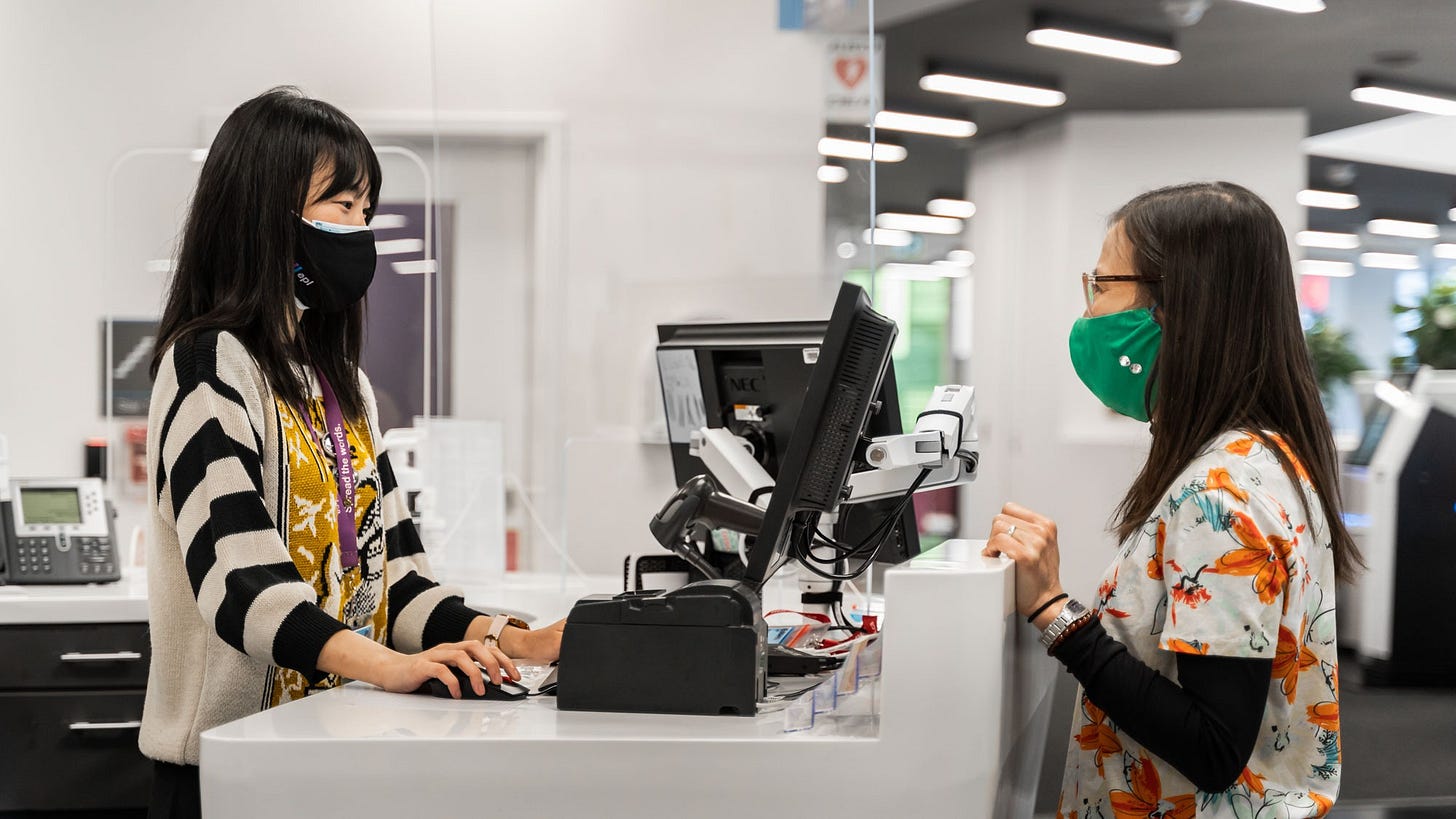
Tommi: Your point on the mundane makes me think of a lot of my conversations with library staff lately, especially in the Edmonton project. When we started and ended our collaboration, I asked the staff to draw examples of convivencia. They drew things like, ‘Can you help me log into this website?’ or ‘Can you help me get this computer working?’ That is the daily convivencia. That’s why I really appreciate this emphasis on the mundane. We easily reduce community and democracy to debate and dialogue as the only meaningful contributions. But one of the biggest contributions of public libraries to democracy is simply the bodily experience of sharing space with others. It doesn’t have to be a life-changing moment—just a simple feeling of belonging and feeling seen.
Allison: I agree completely. I'll add something to that.
If we are only engaging in a capital “P” politics with each other, that's actually the most divisive engagement. People then come to it with their identities formed or rigid in some way. But if you're connecting with each other around something totally different, like with the barista, or you're trying to get onto the computer at the library, or you're asking someone where a book is, politics takes a back seat.
Instead, it's just us sharing this space. We may not agree on things, but we're sharing this space anyway. Our agreements or disagreements lose their salience and that's a really crucial thing for communities.
Tommi: Now that your book is out, what has been the response that you've gotten from people who do this work?
Allison: My favorites are from practitioners who feel seen by the book. One of them was from a postal worker in Texas, who was telling me that she had just retired. She said that she agrees that when you have a supervisor behind you saying ‘speed up, speed up, speed up’, it takes away from the work itself. According to her, in the smaller postal offices, you really have a chance to interact with people. She told me about how there would be a long line at Christmas. She would say to the people in the line:”Okay, sing your favorite Christmas Carol.” When she retired, she had a huge goodbye party where customers came and gave her little goodbye cards. She cherished that part of her work. Like, how many people say that they go to the post office to connect. That's not a story we tell ourselves. But she was saying: ‘You're describing my work.’ I love getting those emails.
Tommi: Thank you so much. We really need to get you in front of library folks.
Allison: I would love that. It would be a meaningful audience.
Buy The Last Human Job here.


